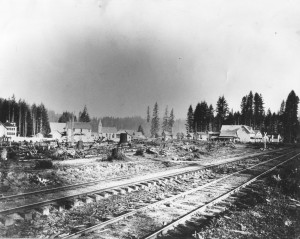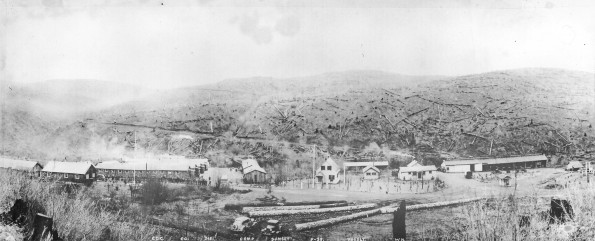Days like these cause a lot of persons in Clark County to look northeastward apprehensively. They are the state and federal forest service employes whose job it is to protect the forests against fire. And they have reason. It will be 50 years ago fairly soon that one of the greatest fires in the history of America began to rage.
 It was the Yacolt Burn, and its echoes – in the form of re-burns – still linger terribly. This was the setting:
It was the Yacolt Burn, and its echoes – in the form of re-burns – still linger terribly. This was the setting:
Pall Terrible
Dark clouds of sooty grey smoke hovered over Clark County in the late summer of 1902. The sun shone dimly and red as it climbed in the east, and showers of ashes sprinkled the parched land.
While crews battled desperately to halt its progress, a wind-fanned blaze raced over acre after acre, section after section of forest land covered with valuable old growth timber.
The fire roared and raged on, and before the ineffective efforts of men could finally halt it more than 100,000 acres of land in Clark County and a major portion of Skiamania County lay smouldering and black.
That fire, tremendous in its scope and destruction even when judged by standards of the modern atomic age, was the original “Yacolt Burn” which left as its monument the still largely denuded portion of Clark County which bears its name.
In visualizing the swath of damage cut by this fire, it is perhaps well to consider that the area it covered constitutes more than 40 per cent of the total land area in Clark County.
Had the Yacolt Burn of 1902 marked the end of fires in that region, Clark County would have reaped an average wealth estimated at $4,200,000 a year ever since from forest crops in the Burn area.
 However, the Yacolt Burn story is not a story of one huge, spectacular fire which swept the length of the county.
However, the Yacolt Burn story is not a story of one huge, spectacular fire which swept the length of the county.
It is a discouraging tale of repeated fires burning over the area.
Nature’s Work Undone
It is a story of natural reforestation starts continually wiped out by flames from a series of fires.
When we speak today of the Yacolt Burn, we refer to that bulging block of country dominating the eastern portion of Clark County and sweeping through neighboring Skamania County. We speak of sharply rising peaks, rolling hills and vast stretches of open, parched land covered only by low green vegetation, ferns, weeds and tall timber snags stretching bleak and white toward the sky.
This is the area that in the past 50 years has nine times been swept by major forest fires, the smallest covering more than 4,000 acres.
Good Forest Crop Land
The land in the Yacolt Burn is potentially highly productive forest land, and has demonstrated its ability to reforest itself despite the continual scorching fires which seem to wipe out each new timber crop before it reaches maturity.
Of the 139,000 acres in the Burn, in Clark County, 81,000 acres are today non-stocked land lying idle and useless. An additional 28,000 acres is covered with young second growth trees, still too young for harvest but gaining in economic value each year with their growth.
But if past patterns are followed, these 28,000 acres of fir trees, together with some 19,000 acres in stages of reproduction for future crops and 7,000 acres in sawtimber, are doomed to perish, as the stands before them, through fire.
Foresters point out that the young trees, green and retaining moisture, present little fire hazard in themselves. For forest fires in regions of green timber can easily be controlled and checked without fear of the blaze skipping and scattering to a major conflagration.
Snags are Menase
But in the Yacolt Burn, section after section of land presents a panorama of dead, dry vegetation or struggling young trees surrounded by a guard of the tall snags.
These snags remnants of once mighty trees which withstood the hot blasts of earlier forest fires, have dried, weakened and rotted under sun, wind and rain.
No longer giants of the forest, they are instead the ever menacing threat to the surrounding land and the major cause of worry to those charged with guarding our forests.
They Feed Flames
It is by means of these tall snags that fires leap rapidly over large areas and defy attempts to contain them while they are still of minor size.
The dry, crumbling tops of the snags supply welcome fuel to the fire, and embers from their heighths are caught by the wind and swept behind fire fighting crews to begin new blazes and destroy the value of fire fighting work done.
With this ready fuel standing patiently ready and the dry, hot summer months descending on Clark County in 1952 may see, as past years have so often done, smoke pouring from the Burn as potential millions of dollars in lumber rises in the cloud of smoke.
